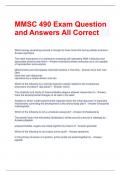Samenvatting
Sustainability: Strat., Innov. & Change, Summary
- Instelling
- Rijksuniversiteit Groningen (RuG)
Summary of all the mandatory Modules, articles, videos, lectures and online sessions, with important figures, lecture slides, all divided per week.
[Meer zien]













